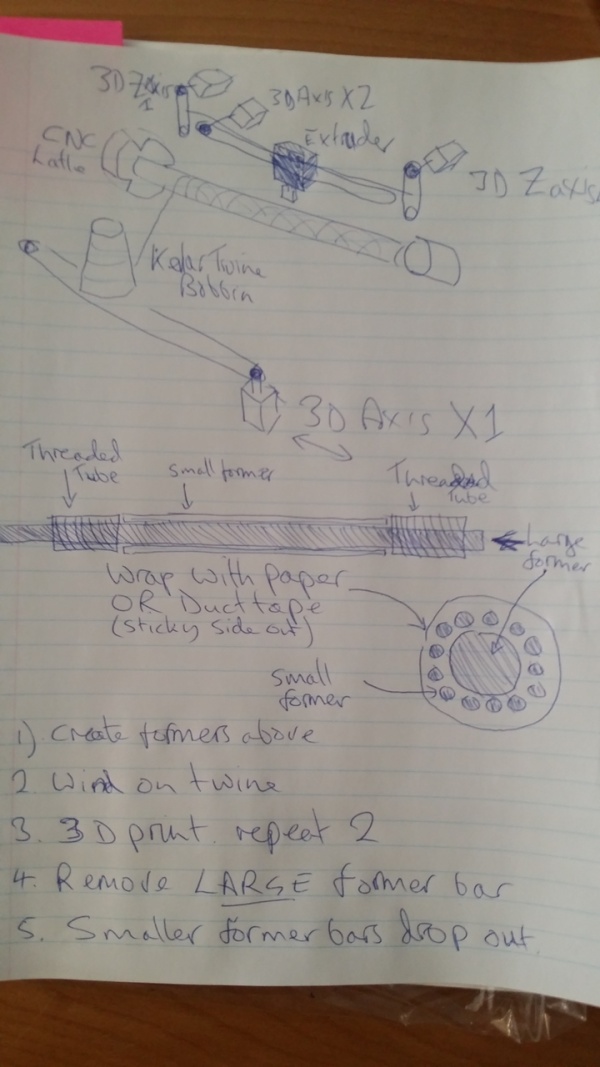Fibre Reinforced Pipe 3D Printer
Fibre Reinforced 3D printed Pipes
An experimental specialist concept for rapid protototyping of vehicles and structurally strong space frame shapes.
http://img.youtube.com/vi/xuXB4aWmcDk/0.jpg
Basic concept is to wrap continuous strand fibre round a former then 3D print a single layer of plastic and interleave those.
Rationale is that space frames and geodesic shapes (including buildings and tents) with light weight pipes can easily be constructed with very efficient use of materials, not requiring solid infill yet still retaining high rigidity and structural strength.
- the CNC lathe part rotates a metal "former" around which you wrap wax paper by hand, to start off
- a bobbin with kevlar twine is moved along as the CNC lathe part turns the former.
- on reaching the other end the bobbin direction reverses in order to create cross hatching.
- the bobbin winding stops and the 3D printer takes over, laying down a layer of 3D printed material over the twine by moving the printer head in the X direction along the length of the former and covering the twine
- however instead of moving the pipe in the Y direction, the *CNC lathe* motor *rotates* the pipe.
- more filament is added until a full rotation is completed and the twine entirely encased.
- another crosshatch of twine is added using the CNC lathe
- the 3D printer part increases Z layer height as usual and adds another layer of plastic.
in this way an extremely strong and lightweight pipe is constructed extremely quickly that should have similar mechanical properties to carbon fibre tubes.
twisting strength along its length, due to the crosshatching, should also be extremely high.
for eco conscious projects, hemp fibre can be considered. (Carbonised to carbon fiber via a kiln or similar device? refomed cellulose (ie rayon) also could work as is or carbonized)
for increased strength, fibre reinforced 3D filament can be considered.
for increased speed, 1.2mm or greater volcano E3Dv6 nozzles cwn be considered, although only for large ID tubes due to the need to have multiple interwoven layers.
TODO details, such as considering epoxy resin at the start and end.
TODO, embedding metal screw threaded fittings into the ends of the pipe as it is formed, to aid in rapid assembly and construction of frames.
Julia Car
- fibre reinforced pipes, kevlar strands crosshatched sandwiched between layers of CNClathe rotated 3Dprinting
- M10 threaded pipe left at one end right at the other is embedded INTO the plastic and of course wrapped with lots of kevlar strand.
- Divergent3D "nodes" 3D printed fibre reinforced plastic, into which pipes are simply screwed.
- Calfee Design technique (bamboo bike with epoxy soakee cloth wrapping nodes) can be considered
- GABoats geodesic canoe using wood slats, more kevlar twine and heatshrink dacron for the outer skin
- and electric and downhill mountainbike parts are then used because the above only weighs 30 to 35kg even at a 5ft x 10ft x 4ft vehicle size.
- actual aluminium or metal parts is drastically reduced, to fastenings, bolts, and intricate pieces etc. -UELVEs_MBC
Comments
- If kevlar is cost prohibitive, spring steel wire appears to be cheap and still 1/3 the tensile strength (150 ksi) (lkcl: or hemp twine. it's ecologically sound and highly effective. multiple strands will need to be wrapped around for cross-hatching, anyway).
- Divergent3D nodes - need thread swivels on one end. Is there a plan for this? (yes, a threaded pipe - one left-hand, one right-hand, can be put over the steel former and then integrated into the 3D print. special section on this TBD).
